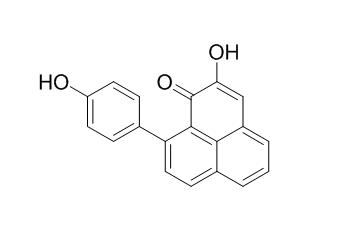Hydroxyanigorufone
Hydroxyanigorufone is a natural product from Musa itinerans Cheesm.
Inquire / Order:
manager@chemfaces.com
Technical Inquiries:
service@chemfaces.com
Tel:
+86-27-84237783
Fax:
+86-27-84254680
Address:
1 Building, No. 83, CheCheng Rd., Wuhan Economic and Technological Development Zone, Wuhan, Hubei 430056, PRC
Providing storage is as stated on the product vial and the vial is kept tightly sealed, the product can be stored for up to
24 months(2-8C).
Wherever possible, you should prepare and use solutions on the same day. However, if you need to make up stock solutions in advance, we recommend that you store the solution as aliquots in tightly sealed vials at -20C. Generally, these will be useable for up to two weeks. Before use, and prior to opening the vial we recommend that you allow your product to equilibrate to room temperature for at least 1 hour.
Need more advice on solubility, usage and handling? Please email to: service@chemfaces.com
The packaging of the product may have turned upside down during transportation, resulting in the natural compounds adhering to the neck or cap of the vial. take the vial out of its packaging and gently shake to let the compounds fall to the bottom of the vial. for liquid products, centrifuge at 200-500 RPM to gather the liquid at the bottom of the vial. try to avoid loss or contamination during handling.
LWT2020, 130:109535
Green Chem.2023, 25:5222-5232
J Agric Food Chem.2024, 72(45):25219-25228.
Phytofrontiers2024, 2690-5442.
Front Microbiol.2021, 12:736780.
J Cell Mol Med.2023, jcmm.17968.
Front Pharmacol.2021, 12:761922.
Biofactors.2018, 44(2):168-179
Molecules.2022, 27(7):2116.
J Pharm Pharmacol.2022, rgac033.
Related and Featured Products
Phytochemistry. 2014 Jul;103:171-177.
Diarylheptanoids and phenylphenalenones from Musa itinerans fruits.[Pubmed:
24766994 ]
METHODS AND RESULTS:
Two diarylheptanoids, musaitinerins A and B, one heterodimeric phenylphenalenone musaitinerone and four known phenylphenalenones, identified as 4-hydroxy-2-methoxy-9-phenyl-1H-phenalen-1-one, musanolone E, Hydroxyanigorufone and irenolone were isolated from the fruits of Musa itinerans Cheesm. Their structures were elucidated using spectroscopic analyses. The antimicrobial activity of these compounds was evaluated against Escherichia coli, Staphylococcus aureus and Candida albicans; the cytotoxic activity of these compounds was also evaluated against human erythromyeloblastoid leukemia (K562) and human alveolar carcinoma epithelial (A549) cell lines, respectively.
CONCLUSIONS:
Musaitinerone and musanolone E exhibited weak effects against the A549 cell line, as compared with adriamycin. However, these two compounds did not exhibit any growth inhibition against K562 cells, S. aureus, E. coli or C. albicans. The other compounds were inactive against all of the tested cell lines and microorganisms, even at concentrations as high as 50 μM.
J Agric Food Chem. 2002 Oct 23;50(22):6330-4.
Constituents of Musa x paradisiaca cultivar with the potential to induce the phase II enzyme, quinone reductase.[Pubmed:
12381112]
A new bicyclic diarylheptanoid, rel-(3S,4aR,10bR)-8-hydroxy-3-(4-hydroxyphenyl)-9-methoxy-4a,5,6,10b-tetrahydro-3H-naphtho[2,1-b]pyran (1), as well as four known compounds, 1,2-dihydro-1,2,3-trihydroxy-9-(4-methoxyphenyl)phenalene (2), Hydroxyanigorufone (3), 2-(4-hydroxyphenyl)naphthalic anhydride (4), and 1,7-bis(4-hydroxyphenyl)hepta-4(E),6(E)-dien-3-one (5), were isolated from an ethyl acetate-soluble fraction of the methanol extract of the fruits of Musa x paradisiaca cultivar, using a bioassay based on the induction of quinone reductase (QR) in cultured Hepa1c1c7 mouse hepatoma cells to monitor chromatographic fractionation.
METHODS AND RESULTS:
The structure and relative stereochemistry of compound 1 were elucidated unambiguously by one- and two-dimensional NMR experiments ((1)H NMR, (13)C NMR, DEPT, COSY, HMQC, HMBC, and NOESY) and single-crystal X-ray diffraction analysis. Isolates 1-5 were evaluated for their potential cancer chemopreventive properties utilizing an in vitro assay to determine quinone reductase induction and a mouse mammary organ culture assay.



